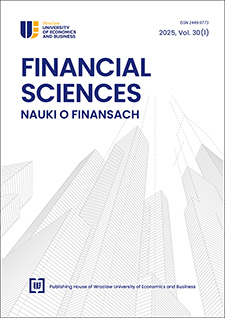Verification of Forecast Effectiveness for Selected Volatility Estimators
DOI:
https://doi.org/10.15611/fins.2025.1.03Keywords:
volatility, volatility forecasting, volatility estimators, OHLC pricesAbstract
Aim: The aim of this study was to determine which volatility forecasting method produces results that are closest to the actual and whether the use of estimators with OHLC prices affects forecast accuracy.
Methodology: This study examined five models – a historical model, GARCH(1,1) and three GARCH models with selected volatility estimators (Parkinson, Garman-Klass and Rogers-Satchell). The sample used daily prices, with each instrument having 2001 observations and a 20-day forecast horizon. Forecast accuracy was assessed using RMSE and MAE.
Findings: The empirical results determined that no specific approach is universally regarded as superior. It is recommended that naive methods or the standard GARCH method be used as they are simpler than the complex models with selected estimators and save operating time. Volatility estimators enhanced accuracy for stocks but not for other instruments. For stocks, estimator-based models obtained better results; for others, classical methods were more effective.
Implications and recommendations: This study can assist researchers in selecting the appropriate model for specific data and indicate whether the use of a different estimator would enrich the results of forecasts. Further research could investigate the impact of higher frequency data on the performance of volatility estimators.
Originality/value: The study examined whether the Polish market responds to volatility estimators similarly to global markets. It also confirmed that the best model varies by instrument: the model with Rogers-Satchell estimator for stocks, GARCH(1,1) for currencies, and the historical method for commodities.
Downloads
References
Bahoo, S., Cucculelli, M., Goga, X., & Mondolo, J. (2024). Artificial Intelligence in Finance: A Comprehensive Review through Bibliometric and Content Analysis. SN Business & Economics, 4(2), 23. https://doi.org/10.1007/s43546-023-00618-x
Bollerslev, T. (1986). Generalized Autoregressive Conditional Heteroskedasticity. Journal of Econometrics, 31, 307-327. https://doi.org/10.1016/0304-4076(86)90063-1
Celestin, M., Kumar, D. A., & Asamoah, P. (2025). Applications of GARCH Models for Volatility Forecasting in High-Frequency Trading Environments. Zenodo, 10, 12-21. https://doi.org/10.5281/zenodo.14904200
Chung, S. (2024). Modelling and Forecasting Energy Market Volatility Using GARCH and Machine Learning Approach. arXiv preprint arXiv:2405.19849. https://doi.org/10.48550/arXiv.2405.19849
Doman, M., & Doman, R. (2009). Modelowanie zmienności i ryzyka. Oficyna a Wolters Kluwer business.
Engle, R. F. (1982). Autoregressive Conditional Heteroscedasticity with Estimates of the Variance of United Kingdom Inflation. Econometrica: Journal of the Econometric Society, 50(4), 987-1007. https://doi.org/10.2307/1912773
Fiszeder, P. (2020). Ceny minimalne i maksymalne w modelowaniu i prognozowaniu zmienności oraz zależności na rynkach finansowych. Wydawnictwo Naukowe PWN.
Ge, W., Lalbakhsh, P., Isai, L., Lenskiy, A., & Suominen, H. (2022). Neural Network-Based Financial Volatility Forecasting: A Systematic Review. ACM Computing Surveys (CSUR), 55(1), 1-30. https://doi.org/10.1145/3483596
Ghalanos, A. (2022). Introduction to the Rugarch Package. (Version 1.4-3). Retrieved March 11, 2023, from www.cran.r-project.org/web/packages/rugarch/vignettes/Introduction_to_the_rugarch_package.pdf
Hansen, P. R., & Lunde, A. (2005). A Forecast Comparison of Volatility Models: Does Anything Beat a GARCH (1, 1)? Journal of Applied Econometrics, 20(7), 873-889. https://doi.org/10.1002/jae.800
Hill, C., & McCullough, B. D. (2019). On The Accuracy of GARCH Estimation in R Packages. Econometric Research in Finance, 4, 133-156.
Hsu, Y. T., Liu, H. C., & Wang, J. N. (2014). How Useful Are the Various Volatility Estimators for Improving GARCH-Based Volatility Forecasts? Evidence from the Nasdaq-100 Stock Index. International Journal of Economics and Financial Issues, 4(3), 651-656.
Hull, J. C. (1989). Options, Futures and Other Derivative Securities. Prentice Hall.
Hung, J. C., Lou, T. W., Wang, Y. H., & Lee, J. D. (2013). Evaluating and Improving GARCH-Based Volatility Forecasts with Range-Based Estimators. Applied Economics, 45(28), 4041-4049. https://doi.org/10.1080/00036846.2012.748179
Investing (n.d.). Historical data on commodity prices. Retrieved March 11, 2023, from https://pl.investing.com/
Jajuga, K. (2007). Zarządzanie ryzykiem. Wydawnictwo Naukowe PWN.
Jajuga, K., & Jajuga, T. (2007). Inwestycje. Wydawnictwo Naukowe PWN.
Knight, J., & Satchell, S. (2011). Forecasting Volatility in the Financial Markets. Elsevier.
Korkusuz, B., Kambouroudis, D., & McMillan, D. G. (2023). Do Extreme Range Estimators Improve Realized Volatility Forecasts? Evidence from G7 stock markets. Finance Research Letters, 55, 103992. https://doi.org/10.1016/j.frl.2023.103992
Ng, K. H., Peiris, S., Chan, J. S. K., Allen, D., & Ng, K. H. (2017). Efficient Modelling and Forecasting with Range Based Volatility Models and Its Application. The North American Journal of Economics and Finance, 42, 448-460. https://doi.org/10.1016/j.najef.2017.08.009
Parkinson, M. (1980). The Extreme Value Method for Estimating the Variance of the Rate of Return. Journal of Business, 53(1), 61-65. https://www.jstor.org/stable/2352357
Patton, A. J. (2011). Volatility Forecast Comparison Using Imperfect Volatility Proxies. Journal of Econometrics, 160(1), 246-256. https://doi.org/10.1016/j.jeconom.2010.03.034
Piontek, K. (1999). Zmienność historyczna i implikowana jako prognozy zmienności instrumentów finansowych. Prace Naukowe/Akademia Ekonomiczna w Katowicach, 1, 325-336.
Piontek, K. (2002). Modelowanie i prognozowanie zmienności instrumentów finansowych. Rozprawa doktorska. Wydawnictwo Akademii Ekonomicznej im. Oskara Langego we Wrocławiu.
Stooq (n.d.). Historical data on stock and currency prices. Retrieved March 11, 2023, from www.stooq.pl
Todorova, N., & Husmann, S. (2012). A Comparative Study of Range-Based Stock Return Volatility Estimators for the German Market. Journal of Futures Markets, 32(6), 560-586. https://doi.org/10.1002/fut.20534
Tripathy, N., Mishra, D., Hota, S., Mishra, S., Das, G. C., Dalai, S. S., & Nayak, S. K. (2025). Bitcoin Volatility Forecasting: A Comparative Analysis of Conventional Econometric Models with Deep Learning Models. International Journal of Electrical & Computer Engineering, 15(1), 2088-8708. https://doi.org/10.11591/ijece.v15i1.pp614-623
Downloads
Published
License
Copyright (c) 2025 Martyna Frankowicz

This work is licensed under a Creative Commons Attribution-ShareAlike 4.0 International License.
Accepted 2025-05-22
Published 2025-07-09








